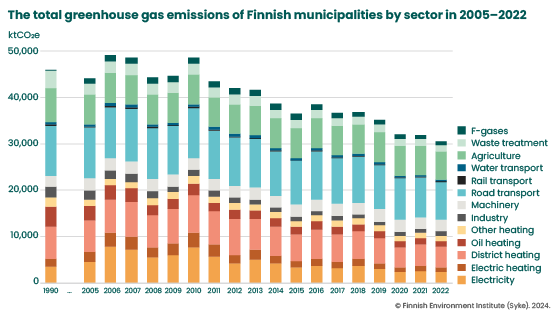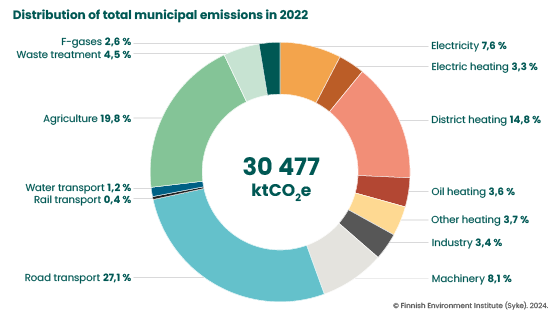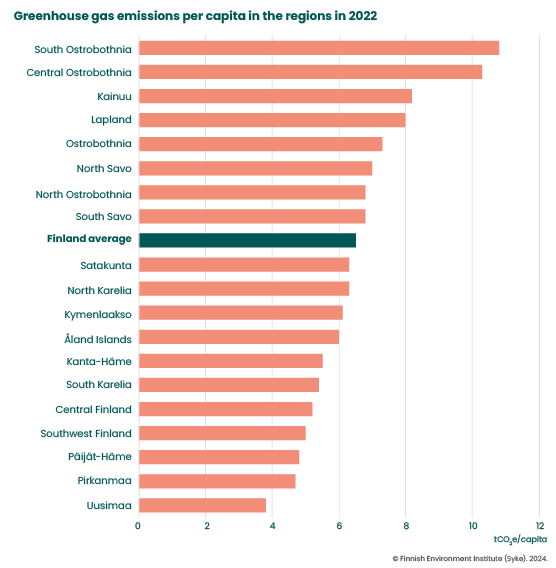Finnish Environment Institute press release, which replaces the information published on 16 May 2024
On 16 May 2024, the Finnish Environment Institute (Syke) published a press release on climate emissions from municipalities. An error was detected in the calculation of road transport emissions after the publication of the press release, which affects the share of emissions in all sectors. For this reason, Syke exceptionally publishes the entire press release with corrected figures and thus replaces the previous press release. The greatest change has been seen in transport emissions, which, contrary to what was said earlier, did not increase, but decreased by 3.7 per cent. This also affected the total amount of emissions: municipal climate emissions decreased by 38 per cent between 2006 and 2022, instead of the 36 per cent reported earlier. The Finnish Environment Institute apologizes for any inconvenience caused by the error.
The combined greenhouse gas emissions of municipalities in 2022 continued to decline. Since the peak year of 2006, emissions fell by 38 %.
Greenhouse gas emissions in 2022 fell by 4,3 % from the previous year. As in previous years, the main sources of greenhouse gas emissions were road transport, which accounted for 27,1 % of total emissions, agriculture for 19.8 % and district heating for 14,8 %.

The greenhouse gas emissions of Finnish municipalities by sector in 1990 and 2005–2022. Emissions are calculated according to the Hinku (Towards Carbon Neutral Municipalities) calculation rules without emission credits. © Finnish Environment Institute
“Municipalities have been working hard on combatting climate change, and the reduction in emissions is particularly visible in the emissions per municipality of the Hinku municipalities that are striving for carbon neutrality. At national level, cleaning up electricity and district heating production has played a major role in reducing emissions. However, there is still work to be done, especially in reducing emissions from vehicle traffic,” says Jari Rantsi, Special Planner at the Finnish Environment Institute.
The 2022 results reflect the impact of Russia's war of aggression in Ukraine. As a result of the war, the use of natural gas and wood fuels was replaced by coal and peat. This was particularly evident in the energy and manufacturing sectors. The emissions intensity of district heating production increased slightly and emissions from non-ETS industries increased by 24,5 % due to an increase in oil use in diffuse sources.
Energy sector cleaning up but emissions from lorry transport increased
Emissions from the use of electricity continued to fall. This was positively influenced by a reduction in energy consumption. Although the use of coal increased, the use of wind power generation reduced the emissions intensity of electricity production.
Emissions from road transport decreased by 3.7 % compared to the previous year. However, emissions from lorry transport increased despite a reduction in the number of kilometres driven. The increase in emissions from lorry traffic was due to the reduction in the distribution obligation. The changes in the distribution obligation are particularly noticeable in diesel-fuelled modes of transport, such as lorries.
Emissions from other fuel sources for heating separate buildings – oil, gas and wood – continued to fall. In particular, emissions from oil heating decreased (-17 per cent).
Emissions from waste treatment decreased by 4.3 per cent and emissions of fluorinated greenhouse gases by 8.1 per cent. Similarly, emissions from rail and water transport, the smallest sectors, also decreased. Emissions from agriculture decreased by 2,8 per cent from the previous year.

Distribution of total greenhouse gas emissions of Finnish municipalities in 2022. Emissions are calculated according to the Hinku (Towards Carbon Neutral Municipalities) calculation rules without emission credits. © Finlands Environment Institute
Emissions calculation for non-road machinery sector refined
The emissions calculation for the non-road machinery sector was updated for construction, mining, forestry and agricultural machinery. Emissions from construction machinery are now allocated on the basis of the surface area of buildings completed in the year of calculation. The allocation of emissions from mining machinery is based on the extraction rates.
When calculating emissions from forestry machinery, the amount of harvested area according to the forest use declarations and whether the harvesting was thinning or end harvesting are taken into account. In the case of agricultural machinery, the surface area and crops cultivated per municipality are taken into account.
The biggest changes were in mining machinery where emissions per municipality sometimes increased significantly. There were also significant variations between municipalities in emissions from forestry machinery.
Differences in per capita emissions between regions
There are still large differences between municipalities and regions in the development of emissions and their distribution across sectors. Per capita emissions were lowest in Uusimaa, Pirkanmaa and Päijät-Häme.
In relative terms, per capita emissions decreased most in North Ostrobothnia, Central Finland, South Savo, North Karelia and Ostrobothnia, where they decreased by 7-8 % compared to 2021.
Differences between regions are explained by factors such as the structure of the economy, especially agricultural dominance, geographical characteristics such as distances and urban structure, and differences in weather conditions and district heating fuel use.

Regional per capita greenhouse gas emissions in 2022. Emissions are calculated according to the Hinku (Towards Carbon Neutral Municipalities) calculation rules. © Finnish Environment Institute
Changes compared with the 16 May 2024 press release
Graphs
The municipal emissions calculation system has received funding from the Life IP Canemure project of the European Union.
The data from the emissions calculations is openly available to all at:
Further information
- Jari Rantsi, Special Planner, Finnish Environment Institute, tel. +358 29 525 1274, firstname.lastname@syke.fi
- Santtu Karhinen, Senior Research Scientist, Finnish Environment Institute, tel. +358 29 525 1889, firstname.lastname@syke.fi
- Eija Ferreira, Senior Research Scientist (oil and other sources of separate heating), Finnish Environment Institute, tel. +358 29 525 2227, firstname.lastname@syke.fi
- Juha Grönroos, Senior Research Scientist (Agriculture), Finnish Environment Institute, tel. +358 29 525 1128, firstname.lastname@syke.fi
- Tommi Forsberg, Specialist (F-gases), Finnish Environment Institute, tel. +358 29 525 1116, firstname.lastname@syke.fi